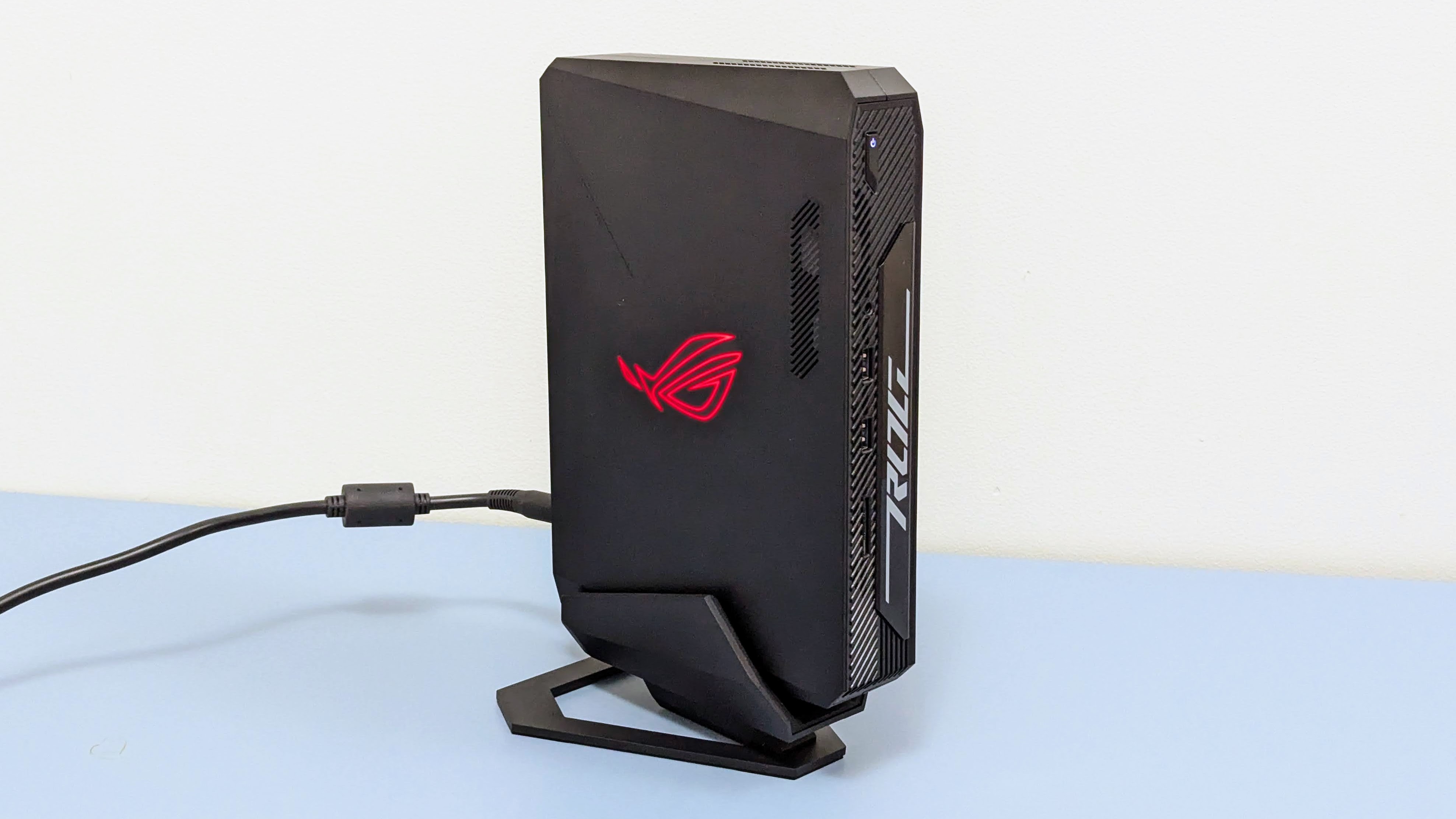
Asus ROG NUC 970: TWO-MINUTE REVIEW
The Asus ROG NUC 970 is designed for those who want a very compact desktop computer that can still give great performance for both gaming and productivity use. As you might have guessed from the NUC name, it’s available as a barebones kit where you buy and add RAM, an SSD and an operating system. For those who want a simpler option, the NUC 970 is also sold by retailers ready to go straight out of the box. The NUC uses hardware normally found in laptops – the base spec is an Intel Ultra 7 paired with a RTX 4060, or an Ultra 9 alongside a RTX 4070.
The NUC 970 I tested was kitted out with an Ultra 9 CPU, RTX 4070 GPU, 32GB of RAM (it can handle up to 64GB), a 1TB M.2 SSD and Windows 11. Setup was just like any new Windows machine, though not quite as streamlined, and I needed to get the latest drivers from the Asus website and install them manually. This process was not a smooth one and my NUC hung while updating the BIOS, recovered itself, and still had ongoing driver niggles even after a factory reset.
The NUC 970 has the usual array of premium ports, including Thunderbolt 4 (40Gbps with DisplayPort 1.4), HDMI 2.1, dual DisplayPort, and a gaggle of high-speed (and low-speed) USB-A ports. You also get super-fast Wi-Fi 6E (AX1690i) and Bluetooth 5.3. The build quality is fantastic – the side cover of the NUC pops straight off after unlatching and the RAM and up to three SSDs can be installed very easily.
The NUC 970 runs the RTX 4070 at up to 140W – the same level as most gaming laptops. While slightly quieter than a similar-spec laptop at full tilt, it’s still quite noisy in turbo mode. The 970 doesn’t push its hardware very hard, and is slightly slower than a premium gaming laptop with the same CPU and GPU. Gaming performance is pretty good overall and the 970 can happily run games like Cyberpunk 2077 at up to 114fps at 1080p, or 72fps at 1440p using Ultra settings with DLSS on. The NUC is a bit quieter during non-gaming use and tends to run the CPU at a higher sustained wattage level than comparable laptops. The 970 can also handle up to 4 screens (5 with the right USB-C setup), making it a very competent productivity machine when not gaming.
Despite the setup niggles I experienced, the ROG NUC 970 is easy to love… until you see the price. It’s very hard to recommend the NUC 970 when, for less money, you can buy a premium laptop that can get better gaming results, or a prebuilt mini desktop computer that has even higher performance. The NUC model with the Ultra 7 / RTX 4060 model is cheaper, but so are the competing options, making the value for money no better.
So where does that leave the NUC 970? The concept is cool, it’s very well built, the drivers need work, and the price needs to be at least 30% lower before I’d consider it competitive against other gaming options.
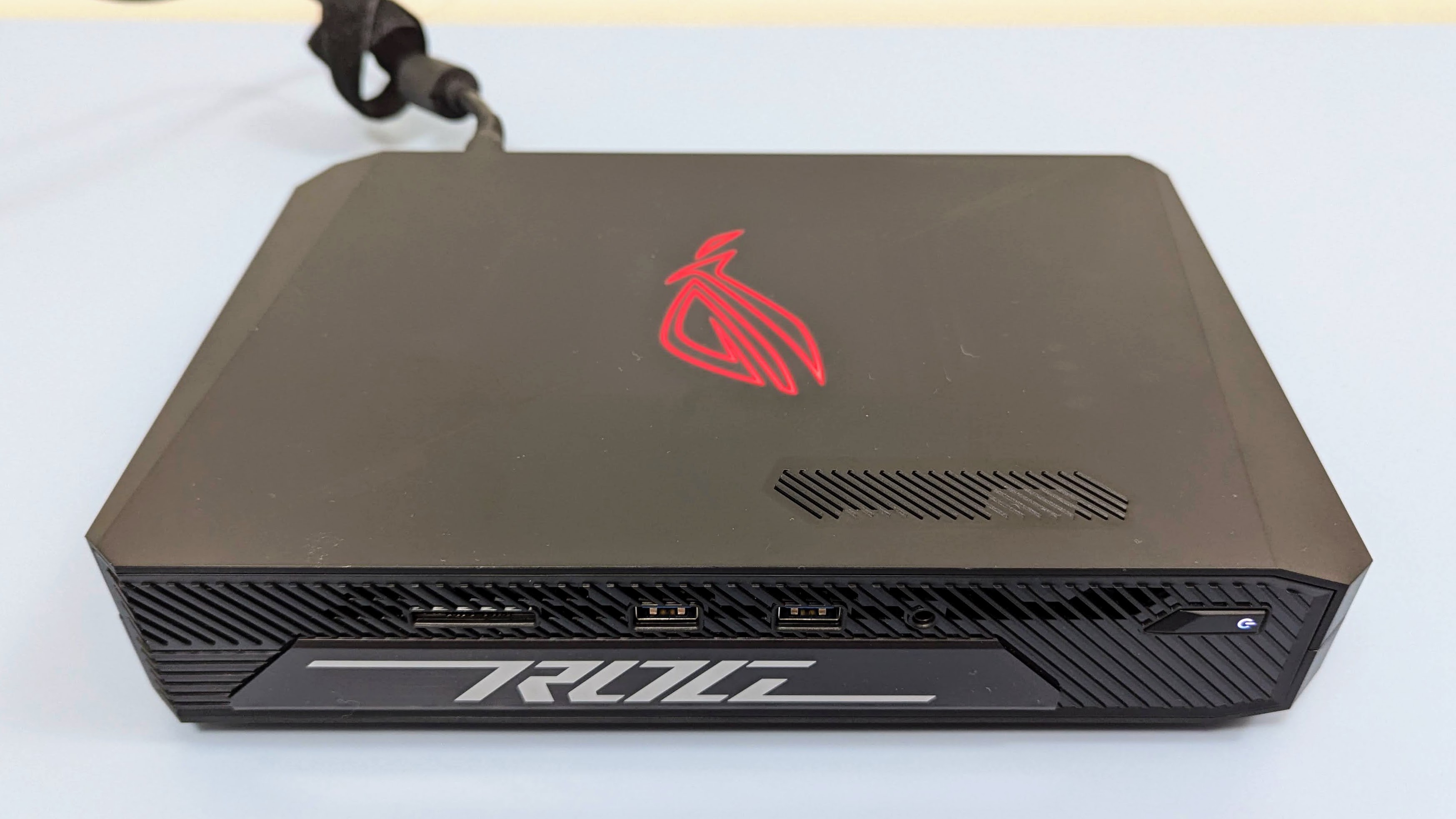
Asus ROG NUC 970: Price & availability
- How much does it cost? $2,199 / £2,199 / AU$4,299
- When is it available? It's available now
- Where can you get it? You can get it in the US, UK, and Australia
The above pricing for the Asus ROG NUC 970 is for the as-tested model, with a Core Ultra 9, RTX 4070, 32GB of RAM, a 1TB SSD and Windows 11 Home. The NUC 970 can be pretty hard to find (especially if you want different customization options) and it commands a price premium with few discounts. There are also barebones systems available without the RAM, SSD and OS, but depending on your region, buying the extras and installing them yourself may not save much money.
Overall the ROG NUC 970 is very expensive for the spec level provided, and it’s cheaper to buy an equally powerful gaming laptop or a much more powerful (but larger) gaming desktop. Outside of niche uses, the ROG would need to be at least 30% cheaper before I’d consider it a compelling buy.
- Value score: 3 / 5
Asus ROG NUC 970: SPECS
The barebones ROG NUC 970 includes an Intel Core Ultra 9 185H CPU (65W TDP) and a Nvidia RTX 4070 8GB GPU (140W TGP). There’s also a ROG NUC 670, featuring an Ultra 7 155H CPU (40W TDP) and RTX 4060 8GB GPU (140W TGP). Aside from the CPU and GPU, the rest of the spec (as listed below) is the same.
- Specs score: 4 / 5
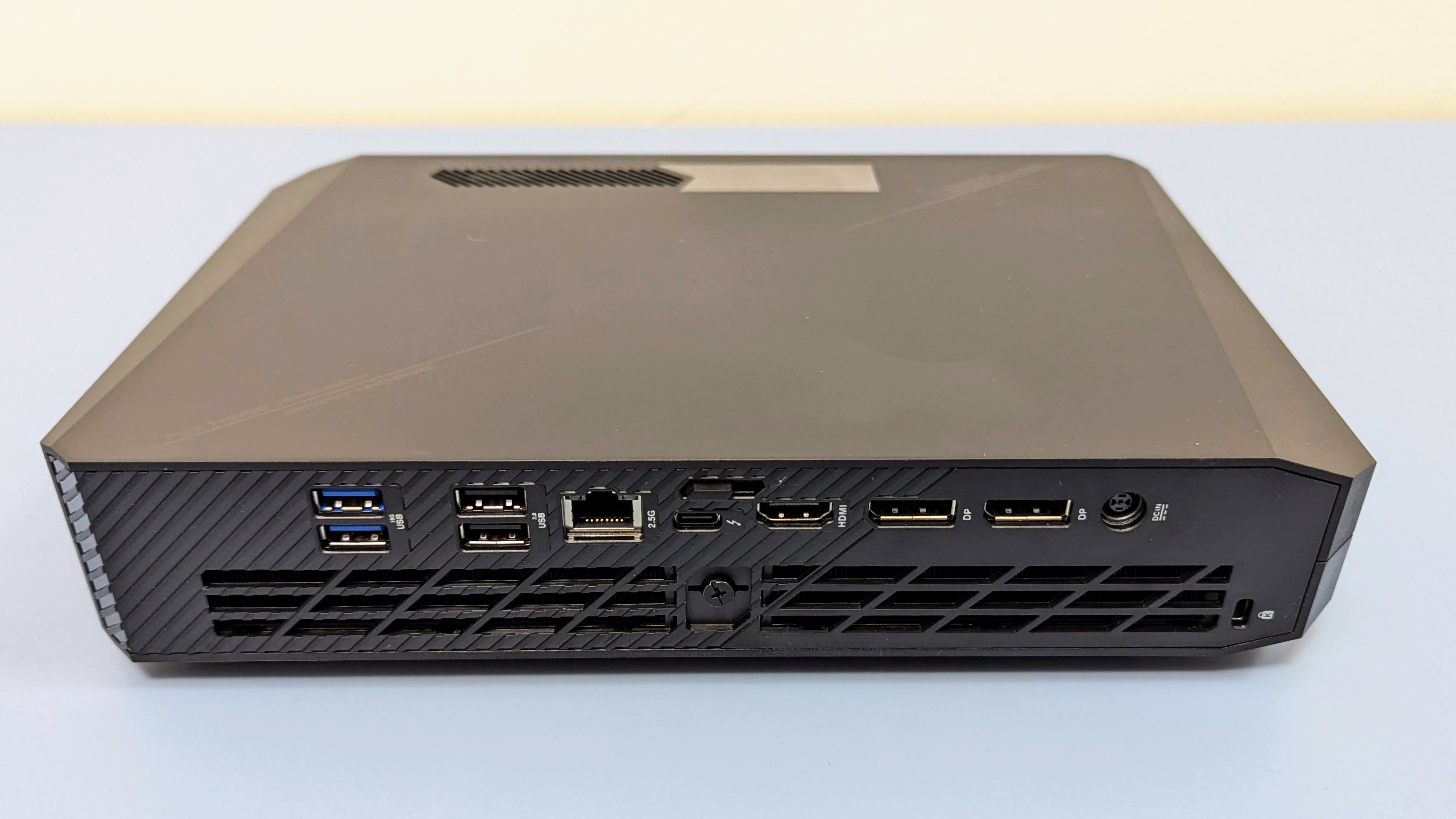

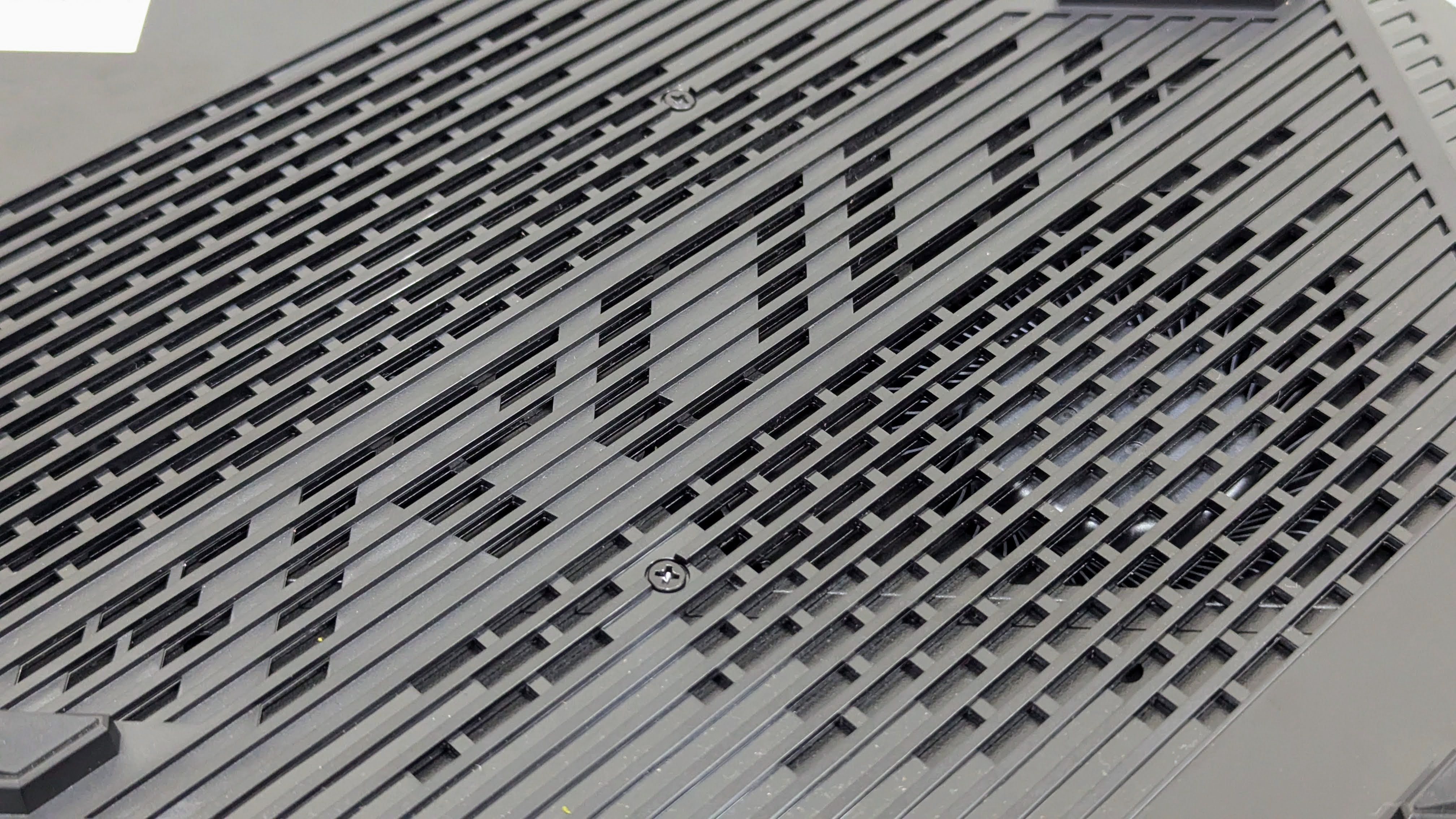
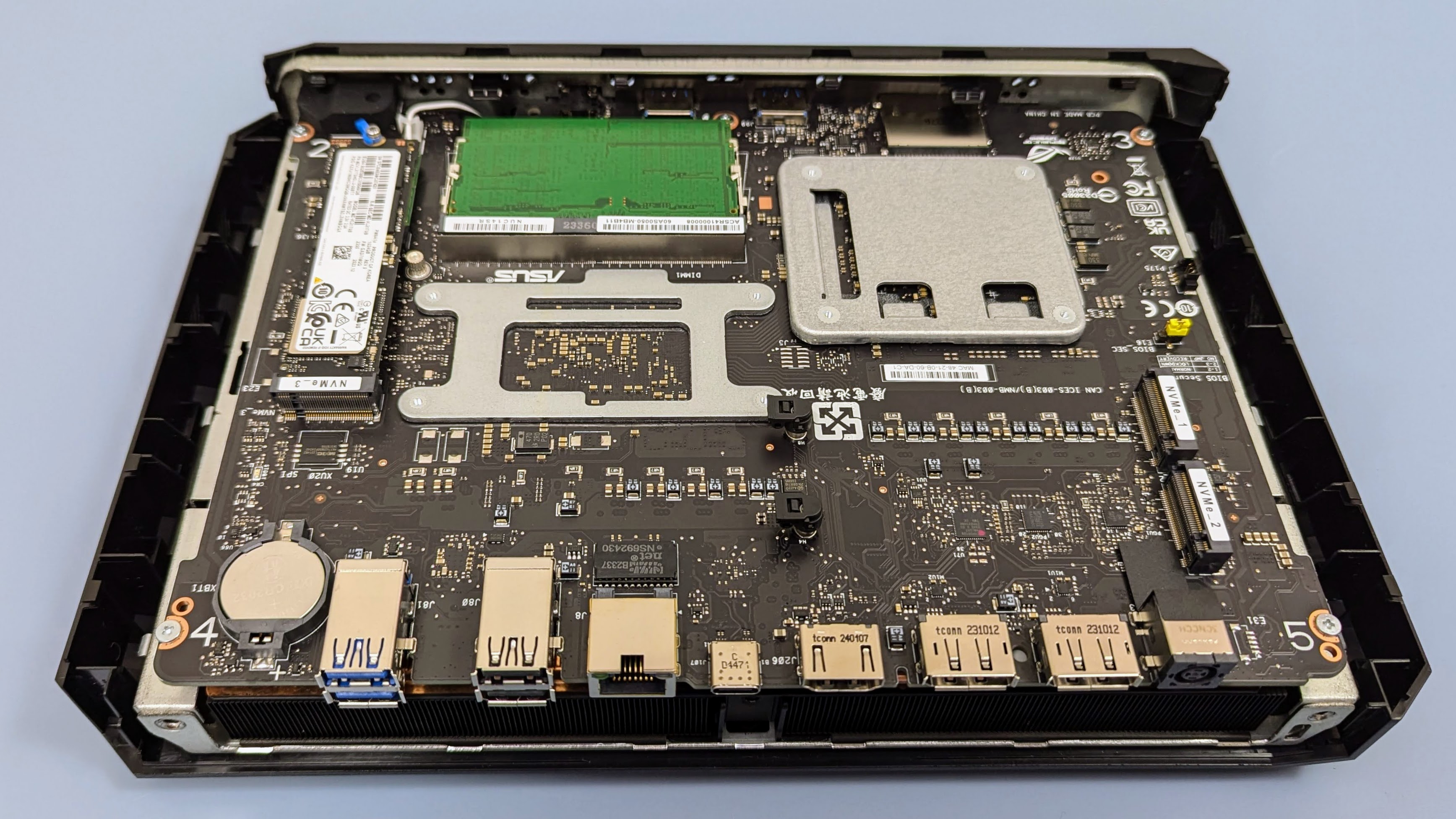
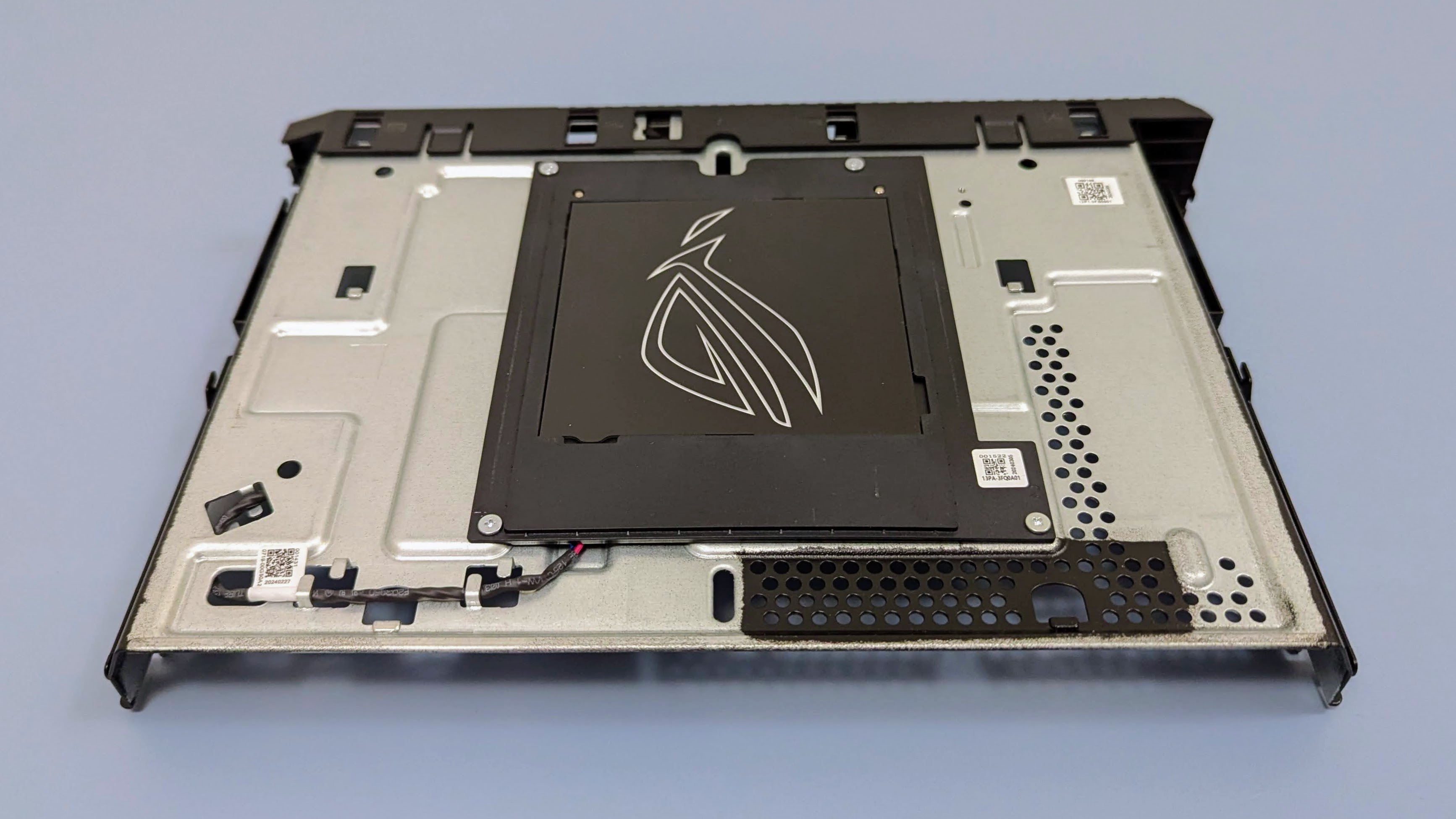
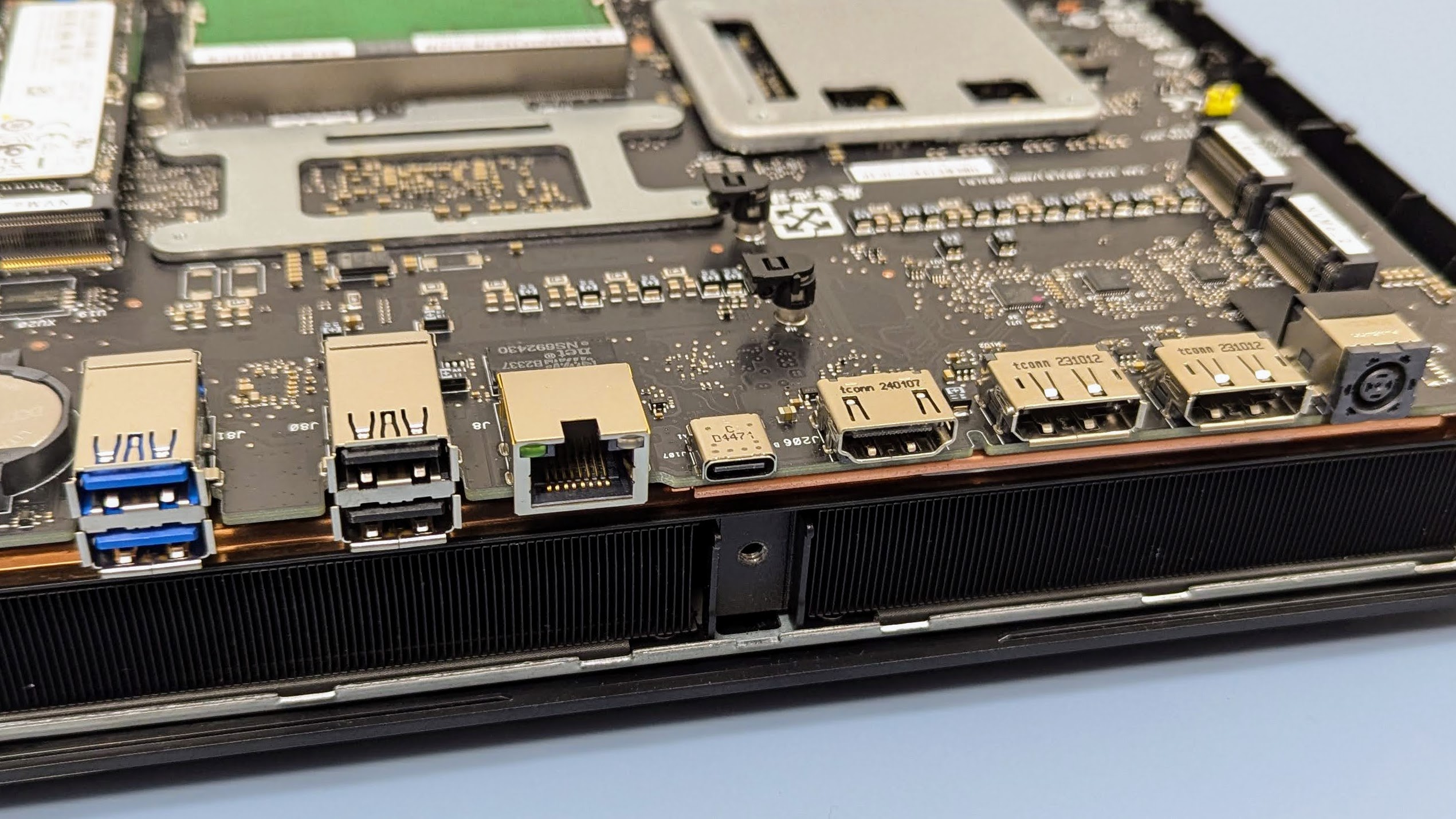
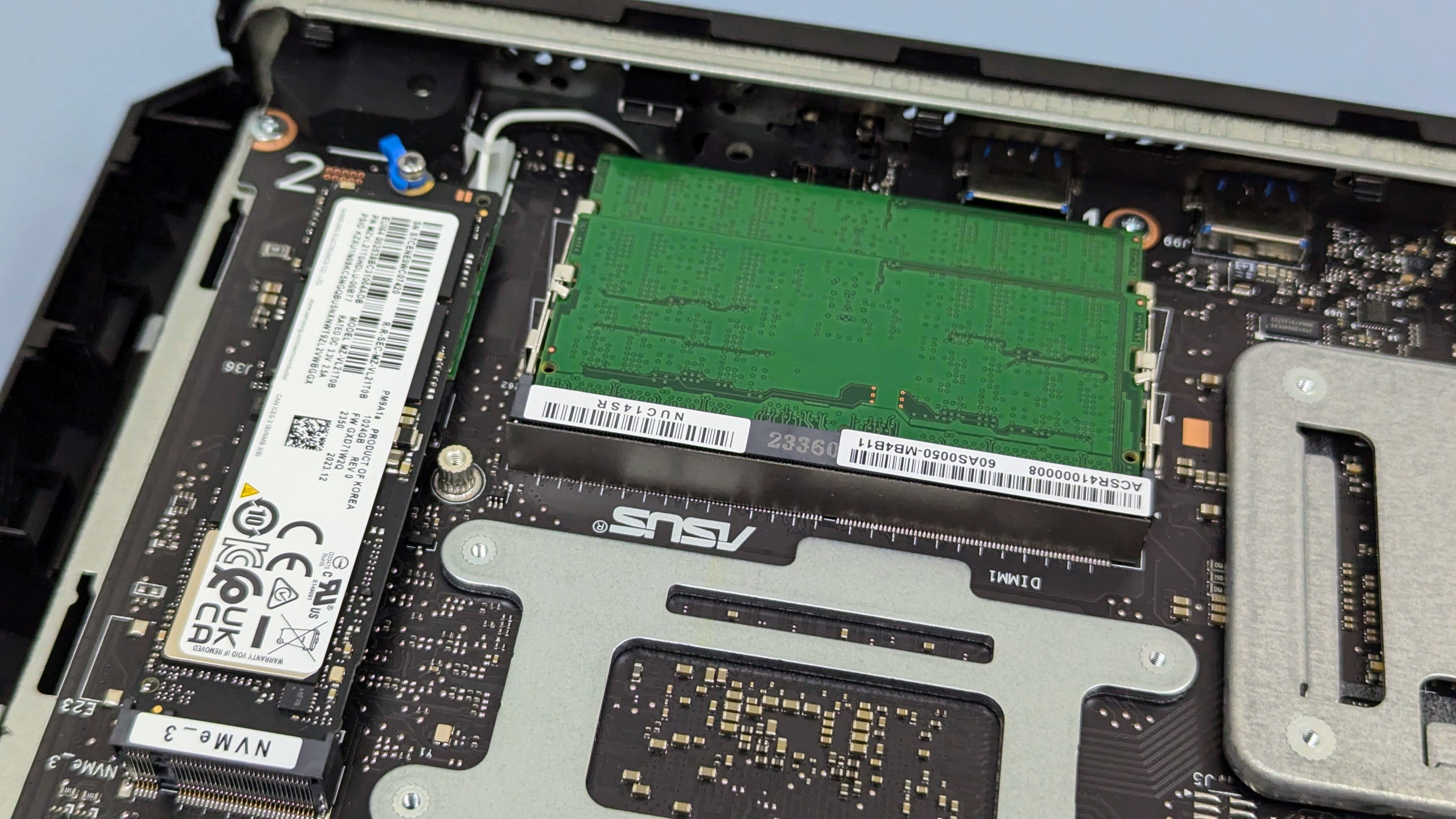
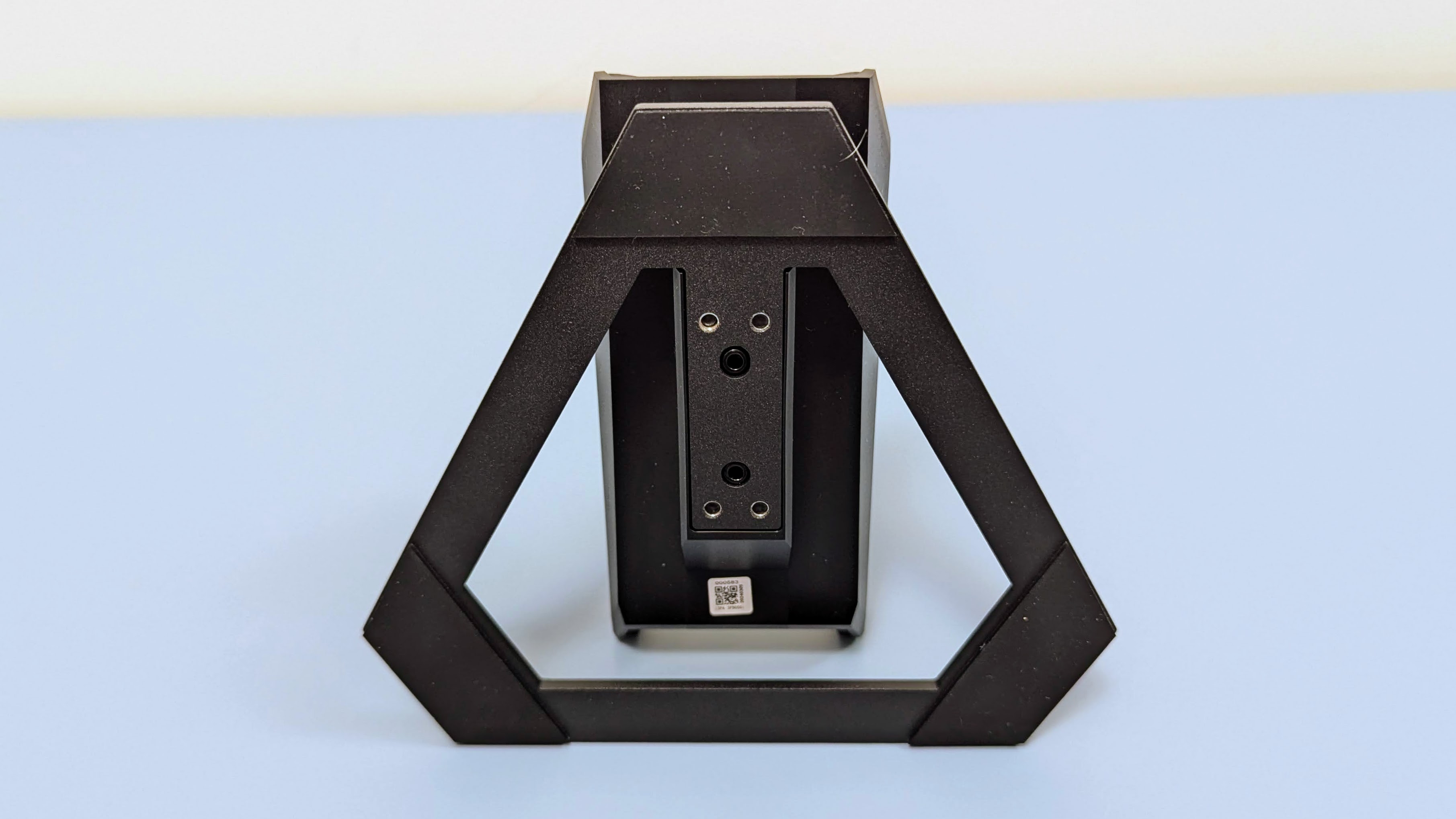
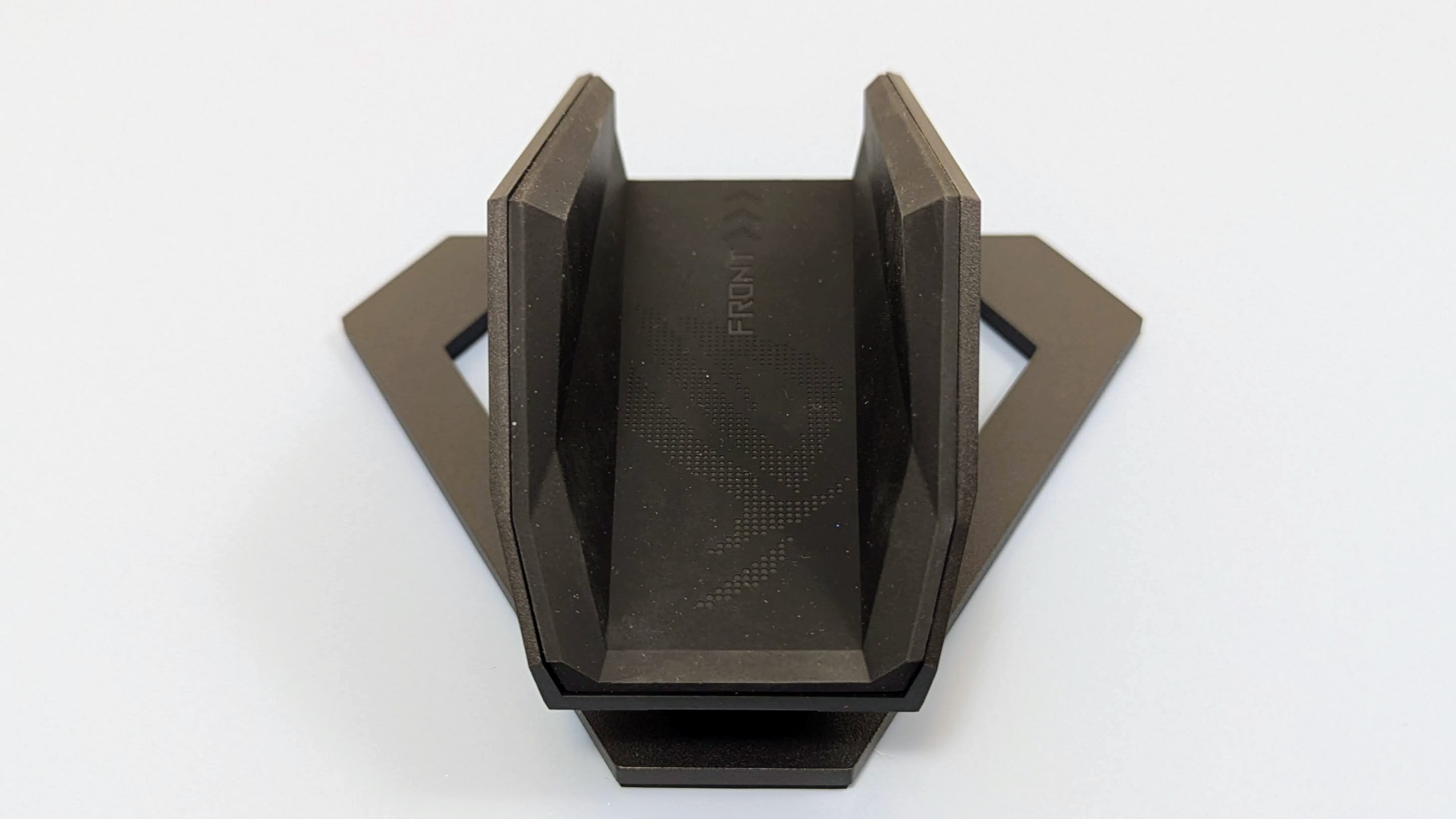

Asus ROG NUC 970: Design
- Compact case
- Great stand
- Plenty of ports
The compact ROG NUC 970 chassis has a 2.5-liter volume (84.5 ounces) – making it larger than the Intel NUCs of yore, but smaller than most miniature gaming PCs. It can sit flat on a table thanks to rubber feet on one side, or be mounted vertically in the heavy-duty aluminum stand. The large power supply is external (like a laptop), but at least the cable is long so the chunky brick can be hidden away under your desk. The little gaming machine has an LED backlight ROG graphic on the side that can be customized with your own logo (or covered up) using plastic inserts included in the box.
The NUC 970 design has the key ports nicely accessible, with dual USB 3.2 Gen2 Type-A, an SD card reader and a 3.5mm headset jack on the front. Round the back there’s a further array of connectivity options, with Thunderbolt 4 (Type-C supporting DisplayPort 2.1 from the iGPU), two more USB 3.2 Gen2 Type-A ports, two standard USB 2.0 Type-A ports, 2.5 Gigabit Ethernet, the power connection and a Kensington lock.
Video output from the RTX 4070 is via dual DisplayPort 1.4 connections or HDMI 2.1 – the latter supporting FRL (Fixed Rate Link) that provides the higher bandwidth needed for options like 4K video at 120Hz. The NUC is also a competent productivity workstation and can be used with up to 5 monitors – though, if not gaming, the Asus NUC 14 Performance model might be a better option as it has the same underlying spec without the game-focused ROG branding.
The NUC 970 case is designed to be easy to open, and the RAM and SSD slots are very accessible for initial memory and storage installs or later upgrades. The tiny case means it’s not particularly easy to clean any dust buildup, and the motherboard and GPU have to be removed to access the cooling system.
Overall the NUC design is quite good, and I especially like the chunky, rubber-padded stand. In the end I actually preferred using the stand "backwards", as it still holds the NUC just as securely, but looks sleeker and gives the side vents some airflow. The ability to DIY a logo is also cool and a nice way to add a touch of personality to the machine. The only things I wish were included in the design are a few more USB-C ports (with one on the front) and removable filters for the fans.
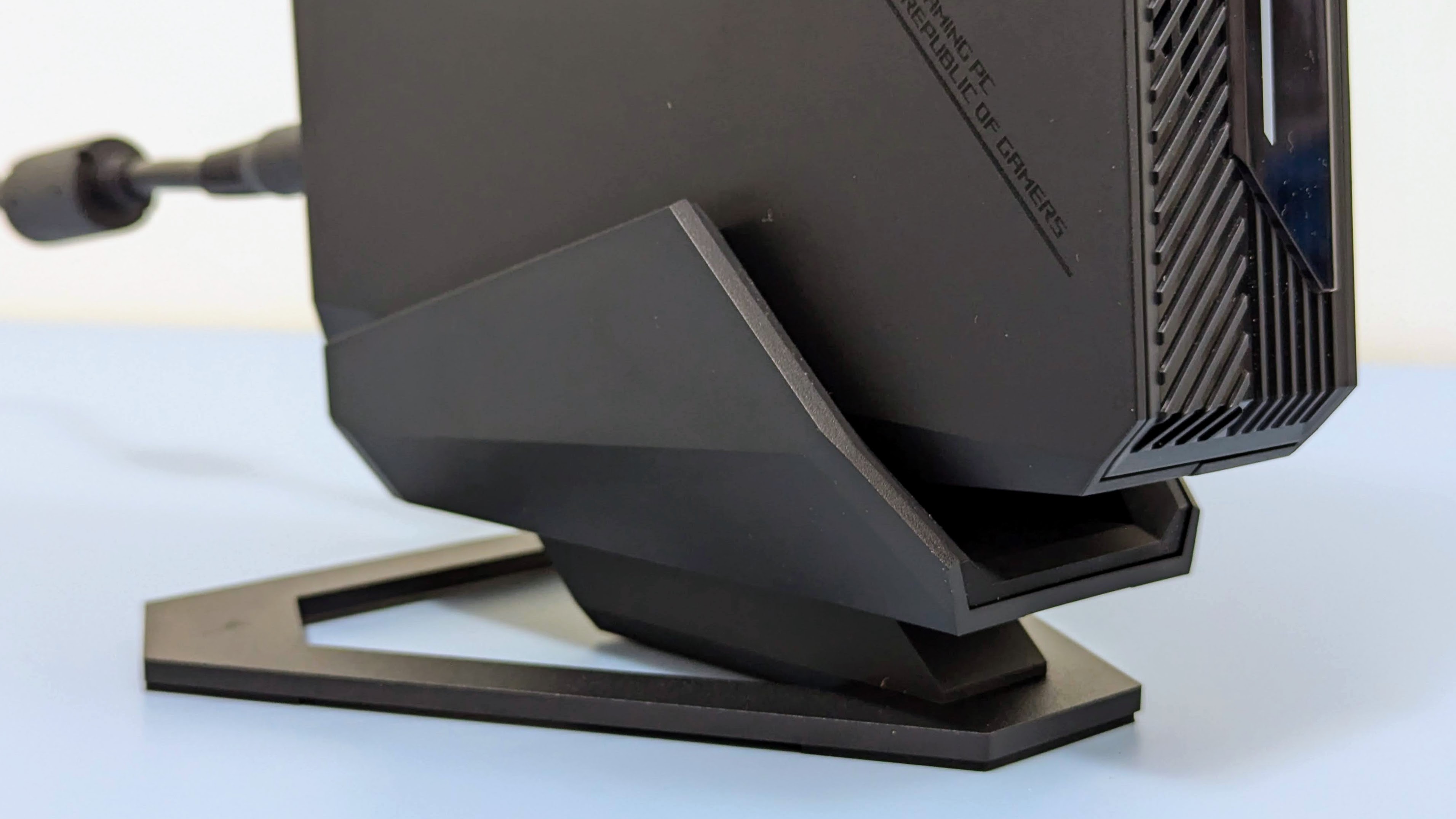
- Design score: 4 / 5
Asus ROG NUC 970: PERFORMANCE
- Solid gaming frame rates
- Fast wired and wireless networking
- Quiet when not gaming
Here's how the Lenovo Legion 5i performed in the TechRadar suite of benchmark tests:
3DMark: Speed Way: 2,978 Port Royal: 7,589; Time Spy Extreme: 6,214; Fire Strike Ultra: 7,188.
GeekBench 6.3: 2,471 (single-core); 12,993 (multi-core)
Cinebench R24: 1,079 (multi-core); 107 (single-core)
PCMark 10: 7,623
CrystalDiskMark 8 NVMe: 7,067 MB/s (read); 5,081 MB/s (write)
Red Dead Redemption II: (Ultra 1080p) 79.3fps
Cyberpunk 2077: 1080p, (Ultra) 65fps; QHD, (Ultra) 55fps
F1 2023: 1080p (Ultra): 70fps
Considering the ROG NUC 970 has laptop-spec internals, running laptop-spec power and thermal profiles, it’s no surprise that it gives laptop-level gaming performance. That’s not a bad thing as the RTX 4070 is a very capable GPU and can give great results. For demanding games, the NUC 970 is best connected to a 1440p gaming monitor that supports variable refresh rate. Gaming at 4K is possible with less demanding games, and achieving higher frame rates requires lower detail levels or dropping the resolution back to 1080p.
I started off my games testing with Cyberpunk 2077 at 1080p, turning ray tracing up to ultra, and the texture detail up to high. At these settings the NUC 970 manages 65fps with DLSS off, and 114fps with DLSS on. Pushing to higher frame rates at 1080p requires reducing the detail levels to low, which allows the NUC 970 to hit 150fps with DLSS on. Testing Cyberpunk 2077 at 1440p, the 970 hits 55fps with all settings on high, and 72fps if DLSS is turned on. Scaling back ray tracing and dropping the detail back to medium allows the NUC 970 to just reach 100fps with DLSS on.
Other games tested (like Red Dead Redemption II and F1 2023), as well as a range of synthetic benchmarks, all tell the same story – the ROG NUC 970 is a competent 1440p gaming machine that performs at the same level as an RTX 4070-equipped gaming laptop.

CPU-only performance is quite good, and in prolonged, heavy, multicore workloads the NUC 970 runs a touch cooler (and much quieter) than a gaming laptop with the same Ultra 9 CPU. That said, the Ultra 9 is easily outclassed by gaming laptops equipped with 13th or 14th Gen i7 and i9 HX series CPUs.
The NUC 970 cooling system is larger than what you’d find in typical 14-inch or 16-inch gaming laptops, but not too different from the setups used in an 18-inch machine. This means the NUC cooling system has no trouble keeping the RTX 4070 from getting too hot without needing to run the fans at full speed. That said, the 970 isn’t exactly quiet when gaming – though it’s better than most laptops.
If browsing the internet or doing light work in quiet mode, it’s near silent, whereas heavier workloads will cause the fans to spin up to audible levels. Overall, the cooling system gets the job done but, considering the price of the NUC 970, I’d like to have seen quieter fans or a setup that helps get higher gaming performance from the GPU.
- Performance score: 4.5 / 5
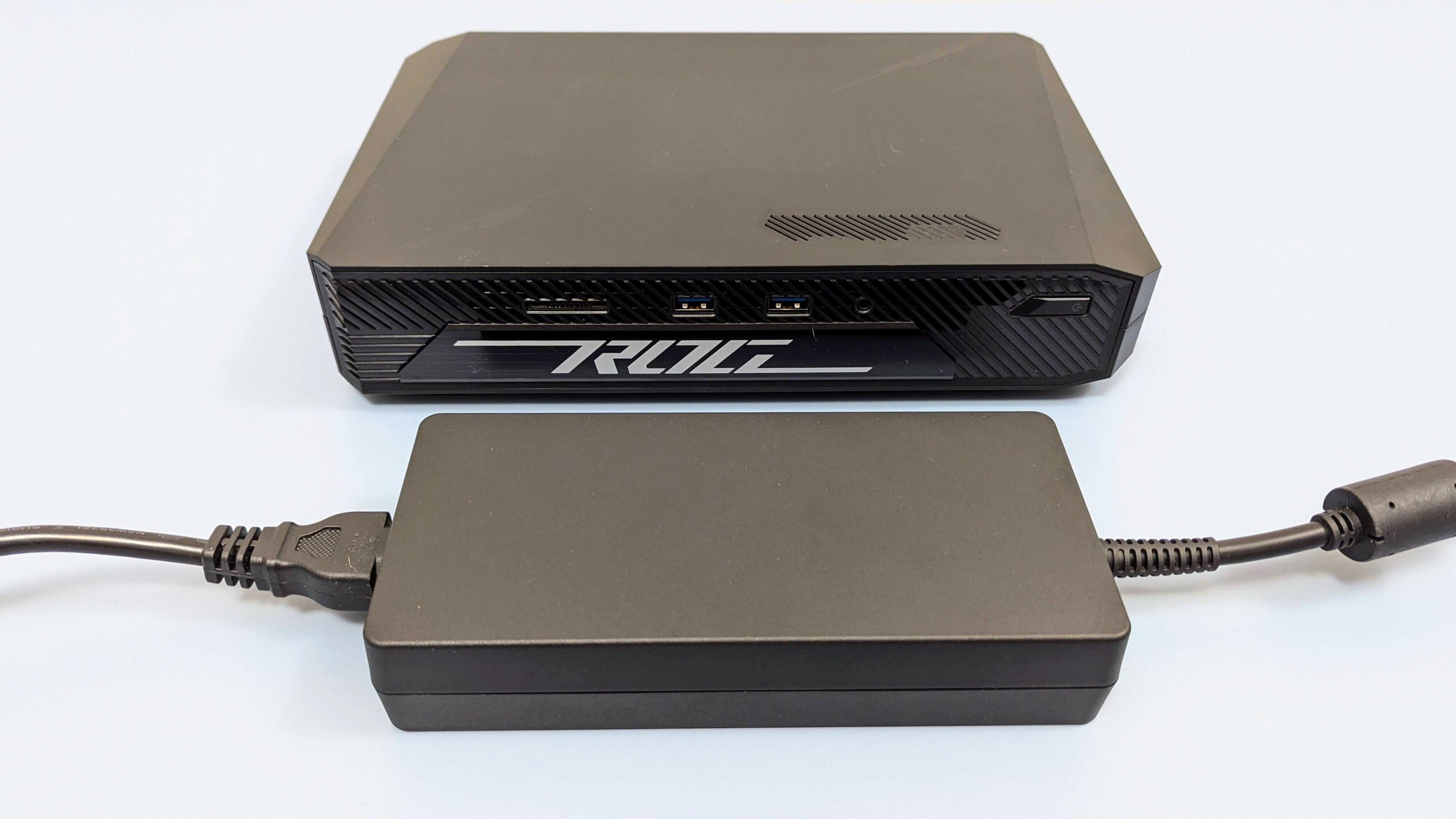
SHOULD YOU BUY THE Asus ROG NUC 970?
Buy it if…
Don’t buy it if...
Asus ROG NUC 970: Also consider
If my Asus ROG NUC 970 review has you considering other options, here are two small gaming desktops and a laptop to take a look at:
How I tested the ROG NUC 970
- Synthetic gaming and productivity benchmarks
- Real-world gaming benchmarks
I ran the Asus ROG NUC 970 through the usual comprehensive array of TechRadar benchmarks, focused on both gaming and productivity use. I tested the ROG NUC 970 for a week, including using it in the living room connected to a TV for casual couch gaming and media playback.







